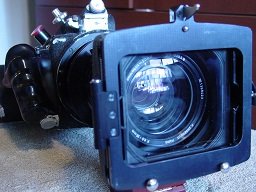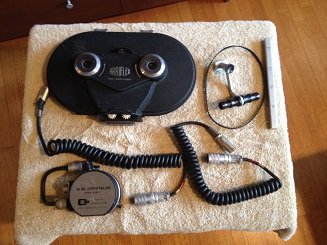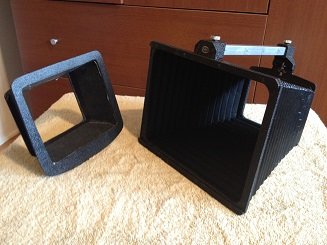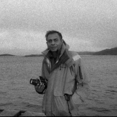Search the Community
Showing results for tags 'film'.
-
Selling my used LOMO Anamorphic zoom 35OPF18-1A 20-120mm with anamorphic adapter (back) which makes it a 40-240mm T3.4 anamorphic monster. Its one of the last Lomo Zooms and higly regarded as one of the best. It can match the Lomo roundfronts primes.. Used but glass is clean and zoom and focus is smooth. Will be shipped in wooden box. Its still in original OCT-19 mount but can be made into PL or use an adapter RED, Micro 4/3, Sony and others are available.. I can send pic´s if interested. My price 2000 euros Located in Sweden read more about it here http://www.cinematography.com/index.php?showtopic=36871
- 2 replies
-
- lomo
- anamorphic
-
(and 3 more)
Tagged with:
-
Hi, Does anyone know of the cheapest place to buy Double 8MM film in the UK? I've looked around various places but it's all in the £25+ for 25ft of Black and White. I've noticed on B&H in the states it's cheap as hell, and would work out at about £7 in UK pounds. Why is it so expensive over here? Am I missing something? Thanks, Andrew.
-
Alright, where to start... I'm a young aspiring filmmaker whose had a passion for making films ever since I was 6. Self-taught, I've made films all on the digital format, and recently, I've been shooting short films on the Canon Rebel T2i. I'm all for manual control, and I'm a pretty big hater of auto focus. Being that most of the filmmakers that inspire me shoot on film, and that it's (sadly enough) slowly dying, I've decided I want to move from digital to film. Now I understand that a great place to begin is with film photography. I've signed up for a photography class (showing you how to shoot and develop film) for my Junior year, and I've also been reading through the web and these forums to understand the film process. My first set of questions are: What still film camera should I begin with? What type of film should I use? Anyway to make a cheap DIY dark room setup? After some practice with that, I wish to begin filming short films (after some more tests of course) on a motion picture film camera. I have in mind using a Super 16mm camera, however that may not be the right choice depending on your responses. So here is my big set of questions for you guys: Which Super 16mm (if I should even use a Super 16mm) should I shoot with? Which film stock should I shoot on? What are the differences between types of film stock? I understand that there's the 'Ultra' modification to convert 4:3 to 16:9, is there any other way to do this (2x anamorphic lenses)? Or could the gate be easily modified on my own? Should I use light meters? If so, which ones do you recommend? What's the best and affordable way of a HD DIY telecine? I understand you can send in your film to get it processed and telecined, but which one is the most reliable and affordable? How to properly light an indoor scene? How to shoot at night (EXT and INT)? Recommended books or websites? __________________________________________________________________________________ As for my tastes and interests (as it could help you answer my questions more specifically): I love Hitchcock, Welles, Nolan, and Kubrick. Film noir has always intrigued me, and I love the look of it. I guess you can say I love low-light photography and cinematography. A modern DP that I dearly love is Wally Pfister, and I understand he shoots on film. If I asked him these questions, what would he say? I also understand Chris Nolan shot Following with an Arriflex BL 16mm (don't know which model). I love the community here, and I hope you guys can understand my switch to film as I think its the true magic of cinema. Thanks ahead of time for checking this post out and taking the time to respond to newbies like myself. I hope to deliver my style and form of storytelling with film. Thanks so much guys! *do note that I own a Bell and Howell MS 30 Super 8mm (no stock)*
-
I am looking for a cinematographer. I am filming a pilot episode for my short drama next week Monday and Tuesday in Watford (UK) and next week Friday in Middlesex Hendon (UK). Then the following week beginning the 21st we plan on filming episode 2. We have a few independent production companies interested in this drama. Would you be available? Do you have your own equipment? For more information email me at jevan_buckley@hotmail.co.uk Thank you Jevan
- 2 replies
-
- cinematographer
- student
- (and 7 more)
-
Hey friends, I have been working on this film for the last year, shooting all in 4K (Via Red Epic or time lapses from a Canon MKIII processed into 4k standard 3840x2160) Please take a look and let me know what you think: Watch in 4K Would love to hear your feedback. If you dig this project help us finish it by sharing this link: https://www.kickstarter.com/projects/1503578410/secrets-of-the-west-a-4k-adventure Thanks all!! -James
-
Hi all, I've recently finished shooting a music video on 4-perf 35mm, 5219. I'm about to send the film off for processing/transfer and I'm sort of stuck as to whether I should get an HD telecine or a 2k scan. The price difference given the amount of film I'm working with is not that large of a concern. My lab of choice (the wonderful Video and Film Solutions in Maryland) uses a Spirit for both. Now obviously, as it's a music video, it'll only ever be viewed on computer screens, so I'm sure the difference won't be too drastic between the two, but there are still some factors to consider. First off, a solid amount of the video is shot in a city (Richmond, VA) at night, with only available light, meaning I was basically consistently rating the film at around 2000 ASA, sometimes higher. So grain will definitely be an issue, and on top of that, I plan on pushing a few of the rolls 1 stop. From my previous experience with 2k scans, it seems as if the higher resolution relative to HD makes grain seem even more apparent in scans than it does in telecine, so would the combination of the thin negative, the push, and the 2k scan make the grain way too intense? I understand that "way too intense" is a vague quantifier, so I guess to put it a bit better, would I be better off in terms of keeping the grain at a manageable level (given the negative that I'll be working with) with an HD telecine or a 2k scan? And I guess in a more general sense, what would be the advantages (or disadvantages) of going with 2k in this situation? Also, this may be a stupid question, but just to clarify my understanding, it's definitely possible to maintain the 1:33 aspect ratio with an HD telecine, right? Any time I've previously had HD telecine of 35mm it's been automatically cropped by the lab to conform to a 1920x1080 frame. But theoretically wouldn't it be possible to maintain the full 4-perf frame with no cropping if I specifically instructed the lab and just have bars on the left and right of the frame? The film was framed for and always intended to be presented in that format. Any help is greatly appreciated! Thanks, Dylan
-
Excellent Condition. Please contact Rebecca 206.251.9526 ARRI Follow-Focus (see pages 39-41) ARRI FF3 2-SPEED FOLLOW FOCUS FOR 19MM RODS ARRI, RED, PANAVISION 1 - ARRI FF3 Follow Focus 1 - ARRI FF3 Right Focus Knob 1 - ARRI FF3 Right Focus Knob Extension 1 - ARRI FF3 Prime Lens Gear 1 - ARRI FF3 Zoom Lens Gear 2 - ARRI FF3 Marking Disks 2-speed follow focus for video and film cameras. 2-Speed Follow Focus Follow Focus For Video And Film Cameras Efficient Snap-On Mounting Flexible Mounting Options: • Snaps Onto Lightweight Rods • Snap-On Adapter For 19mm Rods • Compatible With FF-4 Accessories
-
Hey guys, I'm looking for a bit of advice, stock-wise. We're shooting the first ten minutes of our feature film this month and unfortunately my DP is as unfamiliar with film as I am. For outdoor scenes, I'm looking into the KODAK Vision 3 250D. One shot in particular, we transition from the roof of our building to the inside of our apartment. I dug up an article on Fuji's old 250. The tester claimed it would work very well under such a transition. I'm assuming that Kodak can achieve the same result? http://www.fujifilm.com/products/motion_picture/lineup/eterna_vivid250d/demo/ what would you recommend, lighting-wise, once we hit the interior. In the same one-shot, we travel quite aways around the apartment. Sometimes, windows are plentiful, sometimes not so much. for everything else, I thought we could use kodak 500t. but I don't know how that would match up either. does anyone know if I'm looking in the right places? if not, can you point me in the right direction. (i also considered throwing an 85 on something like a 200t to achieve the same effect, but I'm new at this, and I don't really know what I'm talking about) thank you for your help, for more information on our movie check us out at po.st/sowhat
-
In the 86-year history of the Academy Awards®, no best picture winner has ever been made without motion picture film technology - a streak that continued with 12 Years a Slave winning the 2014 Oscar®. In addition to best picture, films originating on Kodak also won Oscars® in best foreign language film (The Great Beauty) as well as best actress (Cate Blanchett for Blue Jasmine), best supporting actress (Lupita Nyong'o for 12 Years A Slave), and adapted screenplay (12 Years a Slave). Every Academy Award®-winning actress and supporting actress has had her winning performance captured on film. Earlier in the weekend, Film Independent's Spirit Awards were dominated by 12 Years a Slave which took home awards for best feature, cinematography, directing, screenplay, and supporting actress. In the history of the Independent Spirit Awards, every best picture winner has originated on film. Other films on Kodak that received Spirit Awards were Fruitvale Station (Best First Feature), Blue Jasmine (Best Actress) and Mud (Robert Altman Award). "We're honored so many exceptional filmmakers selected KODAK Film to tell their award-winning stories," notes Andrew Evenski, president and general manager of Kodak's Entertainment and Commercial Films Group. "Filmmakers choose celluloid for the rich detail and bold colors which help convey emotions and visual nuances that resonate with audiences. We're proud of our long history with the motion picture industry - a relationship we look forward to continuing." Kodak's Entertainment Imaging Division is the world-class leader in providing film, digital and hybrid motion imaging products, services, and technology for the professional motion picture and exhibition industries. For more information, visit www.kodak.com/go/motion. Follow Kodak on Facebook (www.facebook.com/KodakMotionPictureFilm), Twitter (@Kodak_ShootFilm) and YouTube (www.youtube.com/KodakShootFilm).
-
- 1
-

-
- Film
- Academy Awards
-
(and 3 more)
Tagged with:
-
My name is Jamila J. Brown and I'm a screenwriter looking for a cinematographer to bring my short film to life. The film is called "Gofish" and it's about an intercultural friendship between a black and Jewish girl take place in Crown heights, Brooklyn shortly after the riot of 1991. If you're interested in being apart of this project please email me your resume and short clip(if you have) of your work at jamilajjb@gmail.com
-
Hi! Met Film School in London has got these two weekend-courses that I would love to recommend (filmmaking). The school is located ten minutes walking distance from the station: Ealing Broadway. The famous studio "Ealing studios" is right next to the school. Maybe you can meet up with Daniel Radcliffe after school? Never done anything with filmmaking before? Then you should apply for the course: DSLR for professional filmmaking. It is a weekend course that is designed for those with a working understanding of the principals of cinematography or stills photography that want to apply this knowledge specifically to shooting with digital SLR cameras. You will learn how to get the best from a DSLR camera and how to make use of a selection of accessories specifically designed for video shootings on stills cameras. Through a range of creative exercises you will discover the pros and cons of working with these systems and how to avoid some of the most common pitfalls. Done some filmmaking before? Do you want something more advanced? You should apply for our course: Advanced DSLR for professional filmmaking. This course is designed for students who have previously completed the DSLR for professional filmmaking course, or those with an extensive DSLR and/or cinematography background. This programme covers areas from focus and operating, to sound sync and postproduction workflows. The aim of this programme is to provide you with the fundamental knowledge to shoot and finish DSLR video footage to its highest standard. Apply now on their website: http://www.metfilmschool.co.uk/
-
Located in Los Angeles Vintage - 16 MM Arriflex film camera with footage counter Build in West Germany - BL 54085 Hand mount Mounted with Angenieux lens f. 9.5 - 95 mm zoom 1:22 no. 1368423 Built in France. 1 - 400 ft film magazine 1 - follow focus 1 - Matte box 1 - Crystalok Camera speed controller, model CRBL - 5 from Cinema Products, LA Foam fitted Anvil Case 27" by 22" by 10" Camera is used and operational the last time used. Personal camera of Emmy award winning cinematographer, Robert Collins Sold as is and without any expressed warranties. $1500.00 Available for viewing nancybevins@gmail.com Several Photos at Craiglist listing: http://losangeles.craigslist.org/wst/pho/4323599700.html
-
Hello cinematographers, I'm looking around for creative projects or competitions to do on the weekend. The vimeo weekend challenge is a great exercise but I'm looking for something with more direction and maybe a prize pool. Post your suggestions or any competitions you know of.
-
hey all, posibility of traveling to Haiti with small crew by the end of the month to do some doc style/ live music filming. Was wondering if anyone had done any work or had speant any amount of time in haiti or filming in a similar country. Any crew support? security & health concerns, things in general to watch out for.... anything will help Thanks in advance!!
-
Hi folks! I don't know If I'm in the right forum for this, but I need some help to find a specific sort of lighting filter. I'm looking for a filter that diffuses the light but doesn't add that white color, more like a "clear translucent" / "non-white" frost / diffusion film. Rosco has got a lot of different filters, for example: E-Colour #216: White Diffusion E-Colour #220: White Frost E-Colour #480: Full Atlantic Frost E-Colour #253: Hanover Frost E-Colour #129: Heavy Frost etc. I've made two comparison pics in ps so it would be easier to explain, notice how the second example diffuses equally as much but doesn't add the white color to it. For example (#1), this is a white frost film: ...a this example (#2) is a "non-white" frost film: I don't know if such a diffusion film exist, but if you happen to know any please let me know, I would really appreciate it! Best regards /Patrik
-
Hi, here are some of my shorts. This one was just me testing the Canon 550D, but I think that it turned out OK considering it was a test and my 2nd short: http://www.youtube.com/watch?v=WG1L6CmeSAE This one was an assignment for a workshop I attended (my 4th short): http://www.youtube.com/watch?v=qYpSasiC474 This one is just the first scene of a longer movie that will never reach the internet (this is my favorite one): And finally another one on which I did half of the camera work and I also edited, did coloring and VFX on it: http://vimeo.com/74527145 I'd like to hear your oppinion on these shorts, if you have any tips feel free to post them. :)
-
Hey Everyone, Here's a long form commercial I shot on Super 16mm on the Krasnogorsk K3. I'm really happy with the way it turned it out. I showed it to non industry people and someone asked me how I got it to look the way it does and my I told them, "It looks like that because it was shot on film". I feel like it wouldn't be the way it is if I shot it on any other format. I would definitely appreciate any comments or criticisms! Thanks, Mike https://vimeo.com/74120596
- 12 replies
-
- 2
-

-
- Super 16mm
- Kodak
-
(and 4 more)
Tagged with:
-
Good evenining to everyone, i'm writing this topic because I need help with a project for university. First of all, sorry if this is not the right place to ask for help! Here's the exercise: We have to create a movie, within various movies. We need to choose around 10 films and make them work together, through cutting, creating a whole new narrative. It's not a "mashup" or "remix" movie, it's a movie created by various movies where they combine together in order to get a new narrative and make sense through the rules of classic cinema cutting I tried to search Youtube and Vimeo for examples but all I can find is "mashups" within the best movies of this year or previous ones.. I'm sorry, English is not my native language, but I think I expressed myself correctly! Thank you all, I hope somebody replies me!
-
Good evenining to everyone, i'm writing this topic because I need help with a project for university. First of all, sorry if this is not the right place to ask for help! Here's the exercise: We have to create a movie, within various movies. We need to choose around 10 films and make them work together, through cutting, creating a whole new narrative. It's not a "mashup" or "remix" movie, it's a movie created by various movies where they combine together in order to get a new narrative and make sense through the rules of classic cinema cutting I tried to search Youtube and Vimeo for examples but all I can find is "mashups" within the best movies of this year or previous ones.. I'm sorry, English is not my native language, but I think I expressed myself correctly! Thank you all, I hope somebody replies me!
-
After 6 years hiatus Super16 makes a comeback in British TV industry. Super 16 originated material will be accepted for broadcast. http://www.screendaily.com/territories/uk-ireland/uk-tv-to-allow-super-16-for-hd/5062821.article?blocktitle=MORE-TOP-NEWS&contentID=40294
-
Hi I have been trying to research the best places to get my film 16mm stock developed (UK) and then transferred into digital format. I found a company called idailies Has anyone had any dealings with them? Would love to know if people have used them and what costs where involved Anyone have any footage I can see that they processed would be a treat too many thanks David
-
Producers Keanu Reeves and Justin Szlasa have chosen to create a film element of their feature documentary Side by Side on KODAK VISION3 Color Digital Intermediate Film 2254. This intermediate post production step will also provide the producers with a master for making 35mm film prints. The 2254 will then be archived at the Academy Film Archive, which is providing substantial and instrumental support to preserve this culturally significant exploration into the evolution of digital and film formats. Side by Side recently aired on PBS after a successful run on the 2012 festival circuit, and a limited release in theaters. The Academy is also planning future screenings of the film. “We took a deep dive into the evolution of filmmaking technology and spoke to hundreds of artists and filmmakers to make this documentary,” says Reeves. “What we took away is that, right now, film is the only archival medium that is truly proven. We'd like Side by Side to be available for future generations, and we think creating film elements is the best way to do that.” KODAK VISION3 2254 Film faithfully retains nuances in colors, contrast and other characteristics of digitally created images, and offers exceptional dye stability, allowing for extended asset life. Technicolor New York is providing the transfer services, and the stock will be used as a master for generating a few high-quality release prints for upcoming 35mm film screenings of the documentary. By choosing this postproduction path, Side by Side will be preserved for more than a century. Side by Side investigates the history, process and workflow of both digital and film creation. The movie, directed by Christopher Kenneally, shows what artists and filmmakers have been able to accomplish with both film and digital and how their needs and innovations have helped push filmmaking in new directions. Interviews with directors, cinematographers, colorists, scientists, engineers and artists reveal their experiences and feelings about working with film and digital — where we are now, how we got here and what the future may bring. “At the end of the day, film is still the most stable and reliable preservation medium,” adds Andrew Evenski, President, Entertainment & Commercial Film, Kodak. “Only film offers a standardized, human-readable format that has been in existence for well over a century, and methods for retrieving content from a 35mm frame will exist well into the future. When content is preserved on film, no re-mastering is necessary.”
- 2 replies
-
- 1
-

-
- Documentary
- Kodak
-
(and 1 more)
Tagged with:
-
So, after surfing around the forums and googling, etc. I have sparked up some questions I have about cameras and such. I was reading the Catching Fire thread where Jo Willems and Dave Thompson have actually posted, which is downright awesome, but while reading some of their responses, I found myself getting a little lost. I'm 19 and have been shooting pictures (not much video) for about 5-6 years now and have picked up my fair share of knowledge on my own, and I've never had any "formal training", if we can put it that way. Anyways, I of course know all of the basics about equipment (or I believe I do) and composition and such, but I read articles of DP's being interviewed and then the Jo Willems forum post and I'm so confused sometimes. For example, a bunch of them keep talking about E, C and G lenses and I'm not sure what that translates to. Also I was wondering some stuff about anamorphic, and aspect ratios. I know about the common ones like 16:9 and such, but I've seen them post about 2.39:1, etc. I'm really trying to get this whole cinematographer thing to work after college, with moving to NY and what not, but I feel overwhelmed at times thinking about all the things I have yet to learn! Thanks in advance for any responses, everything is appreciated.
-
Hey folks! I am about to fly for a vacation and I am planning to take a significant amount of Super-8 stock film with me as well as the camera. Afaic there is no regulations against having film or film cameras on board,but my concern is the XRAY check in the airport. Can it affect the film (500ASA and 200ASA) ? Any way around it or am I worrying too much? Thanks a lot! :)



.thumb.jpg.79369da59c0c9d8dbabb45f178b6f21c.jpg)









